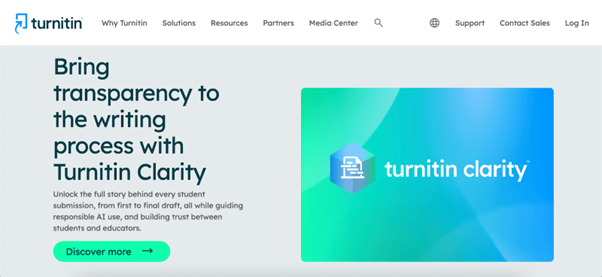AI Tools
Can Turnitin Detect Phrasly AI? 2025 Detection Analysis
- Aug 6, 2025

Ever worried if your AI-assisted writing might get flagged? As someone who specializes in AI detection tools, I get emails about this almost daily, and the anxiety from students and researchers is real. Let's cut through the noise and get straight to the facts. For comprehensive AI writing guidance, refer to Wonkhe’s AI Writing FAQs (UK).
Students and researchers are increasingly worried that AI detection tools like Turnitin might catch content processed through Phrasly AI, even when they use it for legitimate paraphrasing. This creates genuine concern about false positives and unclear detection boundaries.
The short answer: Turnitin can sometimes detect Phrasly AI content, but it depends on several factors, including how you use the tool, what settings you choose, and recent updates to Turnitin's detection system.
This analysis breaks down exactly how both systems work, when detection happens, and what testing reveals about their ongoing cat-and-mouse game in 2025.
| Comparison | Turnitin | Phrasly AI |
|---|---|---|
| Primary Function | Plagiarism & AI detection | AI content humanization |
| Detection Method | Analyzes syntactic predictability, lexical uniformity, semantic consistency | N/A (avoidance tool) |
| July 2024 Update | Added paraphrased AI detection | Currently claims to bypass detection |
| Student View | No AI detection scores visible | N/A |
| Instructor View | Complete AI detection capabilities | N/A |
| Detection Rate | Varies based on content type | Claims 0% detection with proper use |
| False Positive Rate | 1-4% | N/A |
| Cost | Institutional licenses | $19.99/month |
| Best Used For | Academic integrity verification | Paraphrasing assistance (with attribution) |
Here's the part that trips up most users. In my years testing these platforms, I have seen countless students miss this key difference: Turnitin shows different information to students versus instructors.
How Turnitin's AI Detection Really Works
Turnitin doesn't just check for copied content, it hunts for AI fingerprints using sophisticated pattern recognition algorithms. The system analyzes writing for three key characteristics:
- Syntactic predictability - The repetitive sentence structures common in AI writing
- Lexical uniformity - Word choice patterns that humans naturally vary but AI tends to standardize
- Semantic consistency - The way ideas flow and connect in artificially generated text
Turnitin's detection engine was trained on massive datasets comprising both human-written academic papers and AI-generated text from various language models. This training enables it to identify subtle statistical patterns that even sophisticated AI tools like Phrasly leave behind.
The system analyzes entire documents to find the algorithmic rhythms and predictable patterns that distinguish AI writing from authentic human composition. For more information on Turnitin’s AI detection methods, see Turnitin’s official AI Detector page.
Student vs. Instructor Access: What You Actually See
Here's the part that trips up most users. In my years testing these platforms, I have seen countless students miss this key difference: Turnitin shows different information to students versus instructors.
What Students See
- Standard similarity report with plagiarism-focused color coding
- Blue highlighting = no text matches found
- Yellow highlighting = 25-49% similarity to existing sources
- No AI detection scores or AI-specific highlights displayed
What Instructors See
- Complete AI detection capabilities including percentage scores
- Blue highlights specifically marking suspected AI-generated sentences
- Detailed breakdown showing location and analysis of AI-detected content
- Full access to both similarity and AI detection reports
This means students cannot rely on their Turnitin view to determine if their AI usage was detected. All AI-related feedback must come directly from instructors.
Turnitin’s July 2024 Game-Changer Update

In July 2024, Turnitin deployed a significant update specifically engineered to catch paraphrased AI content. This was not just a minor tweak, it was a direct response to tools like Phrasly that help students disguise AI-generated text. For further details, see Turnitin's official announcement.
The update introduced a dual-layer analysis system:
- Blue highlighting: Identifies text directly generated by AI tools like ChatGPT
- Yellow highlighting: Flags content initially created by AI then processed through paraphrasing tools
According to Turnitin's internal data, this update was necessary because their analysis of over 200 million submissions revealed that approximately 11% contained 20% or more AI-written content.
This enhancement specifically targets the "generate-then-paraphrase" workflow that students use to evade detection. The algorithms now look for non-grammatical alterations like synonym swaps that preserve underlying AI patterns.
What Phrasly AI Claims vs. Reality
Phrasly AI positions itself as the solution to Turnitin detection concerns:
- Zero percent AI detection: Their website prominently advertises that Phrasly-processed text receives 0% AI scores when submitted to Turnitin 3.
- Advanced humanization algorithm: Unlike basic paraphrasing tools, it claims to completely restructure sentences while preserving meaning.
- Custom synonym libraries: Technology allegedly goes beyond simple word replacement.
- For more details on their writing tools, check out the AI Writer tool page.
Phrasly also offers a desktop app for users who prefer a dedicated platform.
Performance Testing Results (July 2024)
| Tool | Turnitin Detection | GPTZero Detection | Originality.AI |
|---|---|---|---|
| Phrasly AI (Medium setting) | 0% AI detected | 2% AI detected | 0% AI detected |
| StealthGPT | 86% AI detected | 48% AI detected | 100% AI detected |
| QuillBot | ~100% AI detected | Regular flagging | Regular flagging |
| Humanizer AI | 0% AI detected | 0.9%AI detected | 0% AI detected |
Phrasly demonstrated superior performance at $19.99/month with unlimited usage, while competitors like StealthGPT showed poor results despite similar pricing.
When Phrasly Successfully Bypasses Detection
Multiple independent tests conducted between 2024-2025 demonstrated that under certain conditions, Phrasly could indeed process AI-generated text to receive 0% AI scores from Turnitin.
Success factors included:
- Using Medium humanization settings for optimal balance
- Applying substantial manual editing after processing
- Working with technical/academic content where domain terminology creates natural variation
- Processing shorter documents (under 300 words showed higher success rates)
When Detection Still Happens
Despite Phrasly's claims, failures were also documented:
- A 2023 evaluation found Phrasly-processed content was flagged as 100% AI-generated by Turnitin under certain conditions.
- Post-July 2024 update testing showed significantly increased detection rates, especially with minimal manual editing.
- Raw Phrasly output without manual editing remained more detectable.
Persistent AI Artifacts That Bypass Tools Can't Fix
Even with aggressive humanization, certain AI fingerprints remain detectable:
Statistical Irregularities
- Non-idiomatic phrasings: Unusual transitions and unnatural clause structures
- Mechanical logical progression: Formulaic sentence-to-sentence flow and algorithmic paragraph transitions
- Predictable patterns: Overuse of synonyms, consistent sentence splitting/combining
Detection Technology Response
- Modern detectors identify "AI paraphrase detected" patterns even after humanization.
- Statistical profiles (perplexity, burstiness) remain algorithmically detectable.
- Dual-layer detection systems continue improving against bypass attempts.
Optimal Usage Strategy (For Reference)
Based on testing data, the most effective approach combines tool use with manual effort. From my own obsessive testing, this is the workflow that consistently yields the best results.
Step-by-Step Process
- Input AI-generated text into Phrasly.
- Select Medium setting (best balance of effectiveness and quality).
- Generate humanized version and verify output quality.
- Apply manual editing:
- Add personal anecdotes and opinions.
- Vary sentence length and structure.
- Modify transitions and paragraph breaks.
- Include region-specific language when appropriate.
- Ensure logical coherence and flow.
Content Type Performance
| Content Type | Detection Risk | Success Factors |
|---|---|---|
| Technical/academic papers | Lower | Domain-specific terminology creates natural variation |
| Generic essays | Higher | Standard topics show more predictable AI patterns |
| Creative writing | Moderate | Stylistic elements can be harder to humanize |
Academic Integrity: The Real Risk
Now for the serious talk. As someone who lives and breathes this stuff, I can tell you that getting a 0% AI score is worthless if you end up in front of an academic integrity board.
What Universities Consider Violations
- Uncited AI-generated content classified as plagiarism/academic misconduct
- AI paraphrasing without attribution treated as contract cheating
- Misrepresenting AI work as original student output
- Deliberate evasion of detection systems
Consequences
Academic penalties include:
- Failing grades
- Academic probation
- Disciplinary hearings
- Expulsion
The Gray Area
Most universities cannot base penalties solely on AI detection scores. However, proper attribution and transparency about AI tool usage remain the only academically acceptable approaches.
Current Detection Rates and Accuracy
The empirical data shows:
- Turnitin's false positive rate ranges between 1-4%, meaning some legitimate human writing gets incorrectly flagged as AI.
- Success rates vary dramatically by implementation:
- Basic Phrasly usage: 50-70% detection rate
- Phrasly with optimized settings: 10-30% detection rate
- Phrasly with optimized settings + manual editing: 0-10% detection rate
Critical timeline difference: Content that bypassed detection in early 2024 would likely be caught by current Turnitin algorithms.
Bottom Line: Can You Rely on Phrasly?
Phrasly's ability to bypass Turnitin depends on three critical variables:
- Timing relative to Turnitin updates: The July 2024 update significantly changed the game.
- User expertise: Configuration skills and editing quality dramatically impact success.
- Text characteristics: Content type, length, and complexity all influence detectability.
Key limitations:
- No guarantee of complete undetectability due to constant detector updates.
- Advanced tools may still flag paraphrased content.
- Students cannot verify bypass success through their Turnitin interface.
- Academic risks remain substantial regardless of technical success.
While Phrasly can sometimes achieve its claimed 0% detection rate, its reliability is inconsistent against Turnitin's latest algorithms. For those using Phrasly legitimately for paraphrasing assistance, combining it with substantial personal input and proper attribution remains the safest approach.
Frequently Asked Questions
1. Does Turnitin always detect Phrasly-processed content?No, detection is not guaranteed. Success depends on Phrasly settings, manual editing after processing, content type, and whether your submission occurs before or after Turnitin's latest detection updates.
2. Can I see if Turnitin detected my AI usage?Students cannot see AI detection scores in their Turnitin reports. Only instructors have access to AI detection features and highlighting.
3. Is using Phrasly considered academic dishonesty?Most institutions consider using any tool specifically to evade plagiarism detection as academic dishonesty. Using paraphrasing tools as writing aids while adding substantial original content and proper attribution falls into a gray area that varies by institutional policy.
4. How accurate is Turnitin's AI detection?Turnitin claims 98% accuracy, but independent testing shows a 1-4% false positive rate where human writing is incorrectly flagged as AI-generated.
